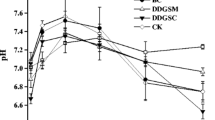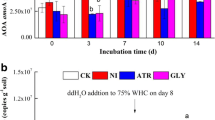Abstract
Gross N mineralization and nitrification rates and their relationships to microbial biomass C and N and enzyme (protease, deaminase and urease) activities were determined in soils treated with dairy shed effluent (DSE) or NH4 + fertilizer (NH4Cl) at a rate equivalent to 200 kg N ha–1 at three water potentials (0, –10 and –80 kPa) at 20 °C using a closed incubation technique. After 8, 16, 30, 45, 60 and 90 days of incubation, sub-samples of soil were removed to determine gross N mineralization and nitrification rates, enzyme activities, microbial biomass C and N, and NH4 + and NO3 – concentrations. The addition of DSE to the soil resulted in significantly higher gross N mineralization rates (7.0–1.7 μg N g–1 soil day–1) than in the control (3.8–1.2 μg N g–1 soil day–1), particularly during the first 16 days of incubation. This increase in gross mineralization rate occurred because of the presence of readily mineralizable organic substrates with low C : N ratios, and stimulated soil microbial and enzymatic activities by the organic C and nutrients in the DSE. The addition of NH4Cl did not increase the gross N mineralization rate, probably because of the lack of readily available organic C and/or a possible adverse effect of the high NH4 + concentration on microbial activity. However, nitrification rates were highest in the NH4Cl-treated soil, followed by DSE-treated soil and then the control. Soil microbial biomass, protease, deaminase and urease activities were significantly increased immediately after the addition of DSE and then declined gradually with time. The increased soil microbial biomass was probably due to the increased available C substrate and nutrients stimulating soil microbial growth, and this in turn resulted in higher enzyme activities. NH4Cl had a minimal impact on the soil microbial biomass and enzyme activities, possibly because of the lack of readily available C substrates. The optimum soil water potential for gross N mineralization and nitrification rates, microbial and enzyme activities was –10 kPa compared with –80 kPa and 0 kPa. Gross N mineralization rates were positively correlated with soil microbial biomass N and protease and urease activities in the DSE-treated soil, but no such correlations were found in the NH4Cl-treated soil. The enzyme activities were also positively correlated with each other and with soil microbial biomass C and N. The forms of N and the different water potentials had a significant effect on the correlation coefficients. Stepwise regression analysis showed that protease was the variable that most frequently accounted for the variations of gross N mineralization rate when included in the equation, and has the potential to be used as one of the predictors for N mineralization.
Similar content being viewed by others
Author information
Authors and Affiliations
Additional information
Received: 10 March 1998
Rights and permissions
About this article
Cite this article
Zaman, M., Di, H., Cameron, K. et al. Gross nitrogen mineralization and nitrification rates and their relationships to enzyme activities and the soil microbial biomass in soils treated with dairy shed effluent and ammonium fertilizer at different water potentials. Biol Fertil Soils 29, 178–186 (1999). https://doi.org/10.1007/s003740050542
Issue Date:
DOI: https://doi.org/10.1007/s003740050542




